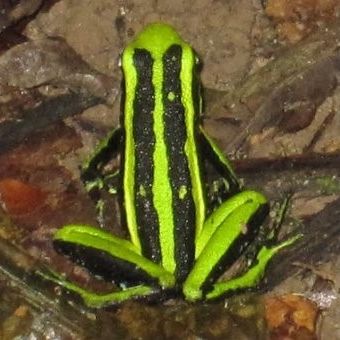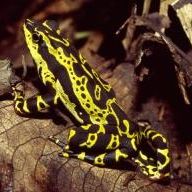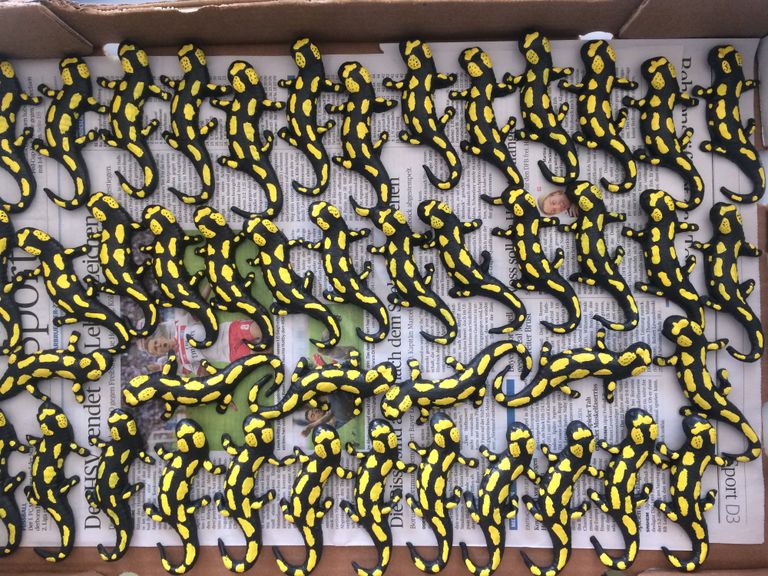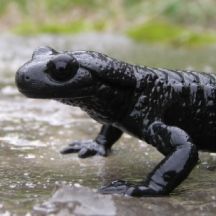Main Current Projects
Updated in December 2025
Neotropical biogeography, with a particular focus on amphibians
Since 2002
As for a biodiversity researcher, it is just a super interesting challenge to explain species' biogeographic and evolutionary histories in Amazonia and the adjacent Andean system.
Our molecular-, field- and model-based research on amphibians contributes to a better understanding of the role of e.g. the various modes of dispersal (such as long distance dispersal), or how secondary contact contributes to evolutionary change within or between species.

Ameerega trivittata, a fellow
found over most of Amazonia.
Photo by Denise J. Ellwein
Systematics, conservation - and 'everything' of harlequin toads (Atelopus)
Since 1990
For 25 years now, we have continuously contributed to the taxonomy and phylogeny of these Neotropical toads as a baseline for follow-up studies and conservation.
The genus Atelopus contains more than 100 species, making it the largest extant lineage of the entire family Bufonidae. Atelopus species usually have small distributions and are mostly allopatric. On the one hand, we observe highly polytypic species and effects of secondary contact. On the other hand, there are cryptic taxa shown to be well separated when employing an integrative taxonomic approach. Cryptic diversity even occurs over different clades. All these aspects make harlequin toads an interesting study system to generally understand evolutionary and biogeographic aspects. See our recent 'roadmap paper' in Zootaxa (Lötters et al. 2025) - in case you have no access, contact me.
Beyond systematics, we have studied aspects of dispersal, aposematism, skin toxins, behavior, skin and gut microbiome etc. Several papes have been published or are on their way, see "Publications".
Approaching the Atelopus study system, next to classical methods, such as examining preserved material in museum collections, we make use of historic DNA from preserved specimens, of environemntal DNA, of next generation morphology via synchrotron CT scanning and genome-related approaches.
Unfortunately, harlequin toads are a sad example and the poster-child of the ongoign global amphibian crisis. Most species of the genus are Cirtically Endangered and many have not been seen for years... making Atelopus one of the most threatened vertebrate genera. For an update of the situation see our paper in Communications Earth & Environment published in November 2023.
In situ and ex situ conservation is badly needed, which is the goal of the Atelopus Survival Initiative (ASI). Our ongoing work on the systematics of these amphibians provides important ground work for conservation practice.

An undescribed toxic Atelopus
species from Ecuador. Photo
by Jos Kielgast
The evoultion and function of traits related to aposematism in brilliant-colored compared to not so colorful amphibians
Since 2012
Many animals are defensive and have signals to warn potential predators. This is generally understood as aposematism, which is a highly complex matter. Generally, warning signals are honest. However, there are sometimes only weak or no signals combined with potent skin toxins in amphibians. This is the case in many South American harlequin toads (Atelopus), but also in European salamanders of the genus Salamandra.
In a phylogenetic frame, we study the evolution and function of visual conspicuousness with regard to toxicity. Part of our field experiments use differently colored clay models of amphibians and visual modelling. We also study the DNA that is left on these models from the attackers.

A 'battery' of fire salamander clay models
ready to be place in the field. Photo by
Stefan Lötters
How do emerging infectious diseases affect amphibian diversity?
Since 2005
Emerging infectious diseases are one of the main threats to global biodiversity. Amphibians, a group severely declining at the global scale, suffer from spreading fungal diseases, in particular the amphibian chytrid fungus, Batrachochytrium dendrobatidis (Bd). We have studied this pathogen in the wild in the European Alps, in East Africa and in South America. See papers published and expect more soon.
Some years ago, a new amphibian skin fungus, Batrachochytrium salamandrivorans (Bsal), was discovered in western Europe. It is lethal to many salamander and newt species, and our native amphibian fauna is at high risk of extinction. The term 'salamander plague' was termed.
Our studies mainly focus on how the new fungus, which might have originated in Asia, spreads and how it affects populations in the wild. In 2015, we have recorded it for the first time in Germany where it is dramatically spreading, making Germany a Bsal hotspot. Drastic declines in fire salamander (Salamandra salamandra) populations are observed, while newts are also affected in the wild but apparently can cope better with the fungus. A particular risks arises for the Alpine salamander (Salamandra atra) because of its relatively small distribution restricted to the Alps.
Apart from monitoring, we have ongoing studies on the fungus' biology, evolution and on host-parasite interactions both in the wild and in the lab.
The knowledge on Bsal in Germany, as of 2020, was summarized in a thematic issue of Salamandra. Check "Publications" for recent papers.

The Alpine salamander is highly
threatened by the emergence of
the salamander plague.
Photo by Ulrich Schulte